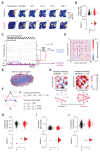Organizing the coactivity structure of the hippocampus from robust to flexible memory
- PMID: 39236189
- PMCID: PMC7616439
- DOI: 10.1126/science.adk9611
Organizing the coactivity structure of the hippocampus from robust to flexible memory
Abstract
New memories are integrated into prior knowledge of the world. But what if consecutive memories exert opposing demands on the host brain network? We report that acquiring a robust (food-context) memory constrains the mouse hippocampus within a population activity space of highly correlated spike trains that prevents subsequent computation of a flexible (object-location) memory. This densely correlated firing structure developed over repeated mnemonic experience, gradually coupling neurons in the superficial sublayer of the CA1 stratum pyramidale to whole-population activity. Applying hippocampal theta-driven closed-loop optogenetic suppression to mitigate this neuronal recruitment during (food-context) memory formation relaxed the topological constraint on hippocampal coactivity and restored subsequent flexible (object-location) memory. These findings uncover an organizational principle for the peer-to-peer coactivity structure of the hippocampal cell population to meet memory demands.
Conflict of interest statement
Figures





References
Publication types
MeSH terms
Grants and funding
LinkOut - more resources
Full Text Sources
Medical
Miscellaneous

